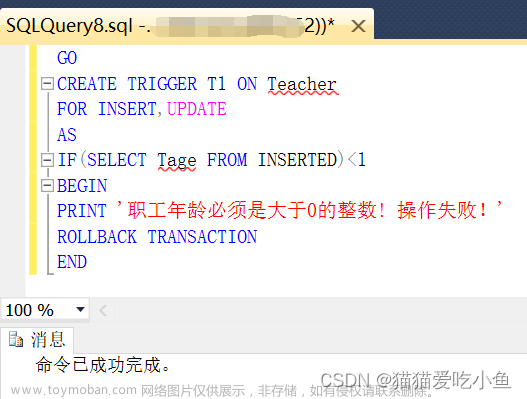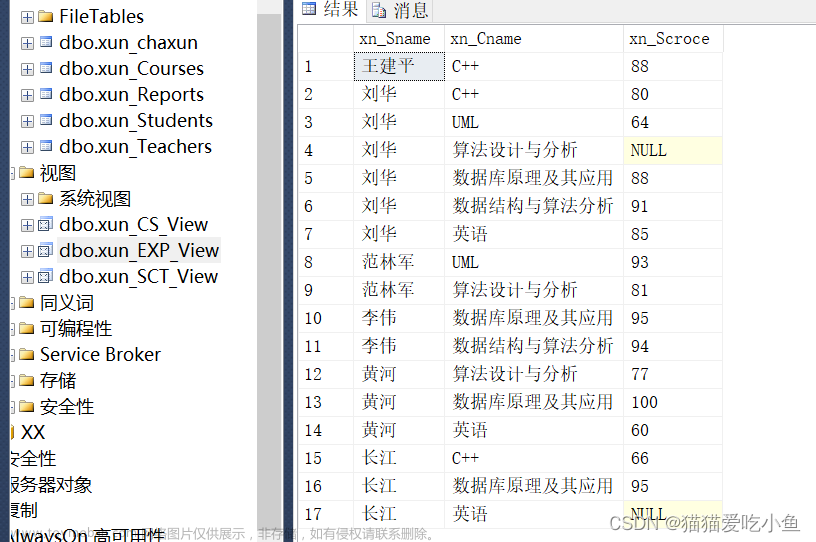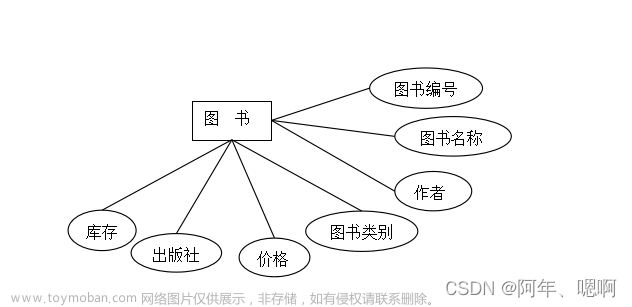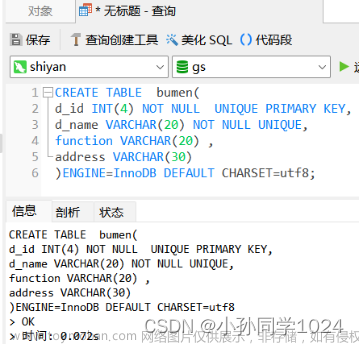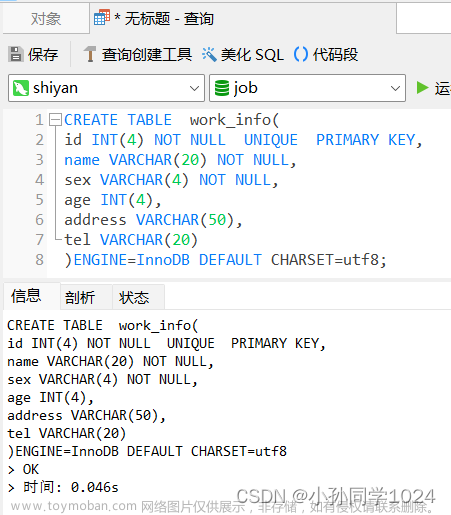一、实验目的
(1)理解四种数据库(MySQL、HBase、Redis和MongoDB)的概念以及不同点;
(2)熟练使用四种数据库操作常用的Shell命令;
(3)熟悉四种数据库操作常用的Java API。
二、实验环境
(1)Linux操作系统(CentOS7.5)
(2)VMware Workstation Pro 15.5
(3)远程终端工具Xshell7
(4)Xftp7传输工具
(5)Hadoop版本:3.1.3;
(6)HBase版本:2.2.2;
(7)JDK版本:1.8;
(8)Java IDE:Idea。
(9)MySQL版本:5.7;
(10)Redis版本:2.8.9;
(11)MongoDB版本:4.2.0;
(12)JDK版本:1.8;
三、实验内容
(一) MySQL数据库操作
学生表如14-7所示。
1. 根据上面给出的Student表,在MySQL数据库中完成如下操作:
(1)在MySQL中创建Student表,并录入数据;
创建Student表的SQL语句如下:
CREATE TABLE student(
NAME VARCHAR(30) NOT NULL,
English TINYINT UNSIGNED NOT NULL,
Math TINYINT UNSIGNED NOT NULL,
Computer TINYINT UNSIGNED NOT NULL
);
向Student表中插入两条记录的SQL语句如下:
insert into student values("zhangsan",69,86,77);
insert into student values("lisi",55,100,88);
(2)用SQL语句输出Student表中的所有记录;
输出Student表中的所有记录的SQL语句如下:
select * from student;
上述SQL语句执行后的结果截图如图所示。
(3)查询zhangsan的Computer成绩;
查询zhangsan的Computer成绩的SQL语句如下:
select name , Computer from student where name = "zhangsan";
上述语句执行后的结果截图如图所示。
(4)修改lisi的Math成绩,改为95。
修改lisi的Math成绩的SQL语句如下:
update student set Math=95 where name="lisi";
上述SQL语句执行结果截图如图所示。
2. 使用MySQL的JAVA客户端编程实现以下操作:
(1)向Student表中添加如下所示的一条记录:
向Student表添加上述记录的Java代码如下:
package com.xusheng.nosql.mysql;
import java.sql.*;
public class mysql_test {
/**
* @param xusheng
*/
//JDBC DRIVER and DB
static final String DRIVER="com.mysql.jdbc.Driver";
static final String DB="jdbc:mysql://localhost/student?useSSL=false";
//Database auth
static final String USER="root";
static final String PASSWD="root";
public static void main(String[] args) {
// TODO Auto-generated method stub
Connection conn=null;
Statement stmt=null;
try {
//加载驱动程序
Class.forName(DRIVER);
System.out.println("Connecting to a selected database...");
//打开一个连接
conn=DriverManager.getConnection(DB, USER, PASSWD);
//执行一个查询
stmt=conn.createStatement();
String sql="insert into student values('scofield',45,89,100)";
stmt.executeUpdate(sql);
System.out.println("Inserting records into the table successfully!");
} catch (ClassNotFoundException e) {
// TODO Auto-generated catch block
e.printStackTrace();
}catch (SQLException e) {
// TODO Auto-generated catch block
e.printStackTrace();
}finally
{
if(stmt!=null)
try {
stmt.close();
} catch (SQLException e) {
// TODO Auto-generated catch block
e.printStackTrace();
}
if(conn!=null)
try {
conn.close();
} catch (SQLException e) {
// TODO Auto-generated catch block
e.printStackTrace();
}
}
}
}


(2)获取scofield的English成绩信息
获取scofield的English成绩信息的Java代码如下:
package com.xusheng.nosql.mysql;
import java.sql.*;
public class mysql_qurty {
/**
* @param args
*/
//JDBC DRIVER and DB
static final String DRIVER="com.mysql.jdbc.Driver";
static final String DB="jdbc:mysql://localhost/student?useSSL=false";
//Database auth
static final String USER="root";
static final String PASSWD="root";
public static void main(String[] args) {
// TODO Auto-generated method stub
Connection conn=null;
Statement stmt=null;
ResultSet rs=null;
try {
//加载驱动程序
Class.forName(DRIVER);
System.out.println("Connecting to a selected database...");
//打开一个连接
conn=DriverManager.getConnection(DB, USER, PASSWD);
//执行一个查询
stmt=conn.createStatement();
String sql="select name,English from student where name='scofield' ";
//获得结果集
rs=stmt.executeQuery(sql);
System.out.println("name"+"\t\t"+"English");
while(rs.next())
{
System.out.print(rs.getString(1)+"\t\t");
System.out.println(rs.getInt(2));
}
} catch (ClassNotFoundException e) {
// TODO Auto-generated catch block
e.printStackTrace();
}catch (SQLException e) {
// TODO Auto-generated catch block
e.printStackTrace();
}finally
{
if(rs!=null)
try {
rs.close();
} catch (SQLException e1) {
// TODO Auto-generated catch block
e1.printStackTrace();
}
if(stmt!=null)
try {
stmt.close();
} catch (SQLException e) {
// TODO Auto-generated catch block
e.printStackTrace();
}
if(conn!=null)
try {
conn.close();
} catch (SQLException e) {
// TODO Auto-generated catch block
e.printStackTrace();
}
}
}
}

(二)HBase数据库操作
学生表Student如表14-8所示。
1. 根据上面给出的学生表Student的信息,执行如下操作:
(1)用Hbase Shell命令创建学生表Student;
创建Student表的命令如下:
create 'student','score'
向Student表中插入上面表格数据的命令如下:
put 'student','zhangsan','score:English','69'
put 'student','zhangsan','score:Math','86'
put 'student','zhangsan','score:Computer','77'
put 'student','lisi','score:English','55'
put 'student','lisi','score:Math','100'
put 'student','lisi','score:Computer','88'
上述命令执行结果截图如图所示。
(2)用scan命令浏览Student表的相关信息;
用scan指令浏览Student表相关信息的命令如下:
scan 'student'
上述命令执行结果截图如图所示。
(3)查询zhangsan的Computer成绩;
查询zhangsan的Computer成绩的命令如下:
get 'student','zhangsan','score:Computer'
上述命令执行结果截图如图所示。
(4)修改lisi的Math成绩,改为95。
修改lisi的Math成绩的命令如下:
put 'student','lisi','score:Math','95'
上述命令的执行结果截图如图所示。
2. 用HBase API编程实现以下操作:
(1)添加数据:English:45 Math:89 Computer:100
实现添加数据的Java代码如下:
package com.xusheng.nosql.hbase;
import java.io.IOException;
import org.apache.hadoop.conf.Configuration;
import org.apache.hadoop.hbase.HBaseConfiguration;
import org.apache.hadoop.hbase.TableName;
import org.apache.hadoop.hbase.client.Admin;
import org.apache.hadoop.hbase.client.Connection;
import org.apache.hadoop.hbase.client.ConnectionFactory;
import org.apache.hadoop.hbase.client.Put;
import org.apache.hadoop.hbase.client.Table;
public class hbase_insert {
/**
* @param xusheng
*/
public static Configuration configuration;
public static Connection connection;
public static Admin admin;
public static void main(String[] args) {
// TODO Auto-generated method stub
configuration = HBaseConfiguration.create();
//configuration.set("hbase.rootdir","hdfs://localhost:9000/hbase");
//configuration.set("hbase.rootdir","hdfs://hadoop102:8020/HBase");
configuration.set("hbase.zookeeper.quorum","hadoop102,hadoop103,hadoop104");
try{
connection = ConnectionFactory.createConnection(configuration);
admin = connection.getAdmin();
}catch (IOException e){
e.printStackTrace();
}
try {
insertRow("student","scofield","score","English","45");
insertRow("student","scofield","score","Math","89");
insertRow("student","scofield","score","Computer","100");
} catch (IOException e) {
// TODO Auto-generated catch block
e.printStackTrace();
}
close();
}
public static void insertRow(String tableName,String rowKey,String colFamily,
String col,String val) throws IOException {
Table table = connection.getTable(TableName.valueOf(tableName));
Put put = new Put(rowKey.getBytes());
put.addColumn(colFamily.getBytes(), col.getBytes(), val.getBytes());
table.put(put);
table.close();
}
public static void close(){
try{
if(admin != null){
admin.close();
}
if(null != connection){
connection.close();
}
}catch (IOException e){
e.printStackTrace();
}
}
}
执行完上述代码以后,可以用scan命令输出数据库数据,以检验是否插入成功,执行结果截图如图所示。
(2)获取scofield的English成绩信息。
Java代码如下:
package com.xusheng.nosql.hbase;
import java.io.IOException;
import org.apache.hadoop.conf.Configuration;
import org.apache.hadoop.hbase.Cell;
import org.apache.hadoop.hbase.CellUtil;
import org.apache.hadoop.hbase.HBaseConfiguration;
import org.apache.hadoop.hbase.TableName;
import org.apache.hadoop.hbase.client.Admin;
import org.apache.hadoop.hbase.client.Connection;
import org.apache.hadoop.hbase.client.ConnectionFactory;
import org.apache.hadoop.hbase.client.Get;
import org.apache.hadoop.hbase.client.Put;
import org.apache.hadoop.hbase.client.Result;
import org.apache.hadoop.hbase.client.Table;
public class hbase_query {
/**
* @param args
*/
public static Configuration configuration;
public static Connection connection;
public static Admin admin;
public static void main(String[] args) {
// TODO Auto-generated method stub
configuration = HBaseConfiguration.create();
//configuration.set("hbase.rootdir","hdfs://localhost:9000/hbase");
//configuration.set("hbase.rootdir","hdfs://hadoop102:8020/HBase");
configuration.set("hbase.zookeeper.quorum","hadoop102,hadoop103,hadoop104");
try{
connection = ConnectionFactory.createConnection(configuration);
admin = connection.getAdmin();
}catch (IOException e){
e.printStackTrace();
}
try {
getData("student","scofield","score","English");
} catch (IOException e) {
// TODO Auto-generated catch block
e.printStackTrace();
}
close();
}
public static void getData(String tableName,String rowKey,String colFamily,
String col)throws IOException{
Table table = connection.getTable(TableName.valueOf(tableName));
Get get = new Get(rowKey.getBytes());
get.addColumn(colFamily.getBytes(),col.getBytes());
Result result = table.get(get);
showCell(result);
table.close();
}
public static void showCell(Result result){
Cell[] cells = result.rawCells();
for(Cell cell:cells){
System.out.println("RowName:"+new String(CellUtil.cloneRow(cell))+" ");
System.out.println("Timetamp:"+cell.getTimestamp()+" ");
System.out.println("column Family:"+new String(CellUtil.cloneFamily(cell))+" ");
System.out.println("row Name:"+new String(CellUtil.cloneQualifier(cell))+" ");
System.out.println("value:"+new String(CellUtil.cloneValue(cell))+" ");
}
}
public static void close(){
try{
if(admin != null){
admin.close();
}
if(null != connection){
connection.close();
}
}catch (IOException e){
e.printStackTrace();
}
}
}
可以在IDEA中执行上述代码,会在控制台中输出如下信息:
(三)Redis数据库操作
Student键值对如下:
zhangsan:{
English: 69
Math: 86
Computer: 77
}
lisi:{
English: 55
Math: 100
Computer: 88
}
1. 根据上面给出的键值对,完成如下操作:
(1)用Redis的哈希结构设计出学生表Student(键值可以用student.zhangsan和student.lisi来表示两个键值属于同一个表);
插入上述键值对的命令如下:
hset student.zhangsan English 69
hset student.zhangsan Math 86
hset student.zhangsan Computer 77
hset student.lisi English 55
hset student.lisi Math 100
hset student.lisi Computer 88
(2)用hgetall命令分别输出zhangsan和lisi的成绩信息;
查询zhangsan成绩信息的命令如下:
hgetall student.zhangsan
执行该命令的结果截图如图所示
查询lisi成绩信息的命令如下:
hgetall student.lisi
执行该命令的结果截图如图所示:
(3)用hget命令查询zhangsan的Computer成绩;
查询zhangsan的Computer成绩的命令如下:
hget student.zhangsan Computer
执行该命令的结果截图如所示:
(4)修改lisi的Math成绩,改为95。
修改lisi的Math成绩的命令如下:
hset student.lisi Math 95
执行该命令的结果截图如图所示:
2. 用Redis的JAVA客户端编程(jedis),实现如下操作:
(1)添加数据:English:45 Math:89 Computer:100
该数据对应的键值对形式如下:
scofield:{
English: 45
Math: 89
Computer: 100
}
完成添加数据操作的Java代码如下:
package com.xusheng.nosql.redis;
import java.util.Map;
import redis.clients.jedis.Jedis;
public class jedis_test {
/**
* @param args
*/
public static void main(String[] args) {
// TODO Auto-generated method stub
Jedis jedis = new Jedis("localhost");
jedis.hset("student.scofield", "English","45");
jedis.hset("student.scofield", "Math","89");
jedis.hset("student.scofield", "Computer","100");
Map<String,String> value = jedis.hgetAll("student.scofield");
for(Map.Entry<String, String> entry:value.entrySet())
{
System.out.println(entry.getKey()+":"+entry.getValue());
}
}
}
在idea中执行程序时,在idea控制台输出的信息截图如图所示:
(2)获取scofield的English成绩信息
获取scofield的English成绩信息的Java代码如下:
package com.xusheng.nosql.redis;
import java.util.Map;
import redis.clients.jedis.Jedis;
public class jedis_query {
/**
* @param xusheng
*/
public static void main(String[] args) {
// TODO Auto-generated method stub
Jedis jedis = new Jedis("localhost");
String value=jedis.hget("student.scofield", "English");
System.out.println("scofield's English score is: "+value);
}
}
在idea中执行上述代码后,在idea控制台输出的信息截图如图所示:
(四)MongoDB数据库操作
Student文档如下:
{
“name”: “zhangsan”,
“score”: {
“English”: 69,
“Math”: 86,
“Computer”: 77
}
}
{
“name”: “lisi”,
“score”: {
“English”: 55,
“Math”: 100,
“Computer”: 88
}
}
1. 根据上面给出的文档,完成如下操作:
(1)用MongoDB Shell设计出student集合;
首先,切换到student集合,命令如下:
use student
其次,定义包含上述两个文档的数组,命令如下:
var stus=[
{"name":"zhangsan","scores":{"English":69,"Math":86,"Computer":77}}, {"name":"lisi","score":{"English":55,"Math":100,"Computer":88}} ]
最后,调用如下命令插入数据库:
db.student.insert(stus)
上述命令及其执行结果的截图如图所示:
(2)用find()方法输出两个学生的信息;
用find()方法输出两个学生信息的命令如下:
db.student.find().pretty()
上述命令及其执行结果的截图如图所示:
(3)用find()方法查询zhangsan的所有成绩(只显示score列);
用find函数查询zhangsan的所有成绩的命令如下:
db.student.find({"name":"zhangsan"},{"_id":0,"name":0})
上述命令及其执行结果的截图如图所示:
(4)修改lisi的Math成绩,改为95。
修改lisi的Math成绩的命令如下:
db.student.update({"name":"lisi"}, {"$set":{"score.Math":95}} )
上述命令及其执行结果的截图如图所示:
2. 用MongoDB的Java客户端编程,实现如下操作:
(1)添加数据:English:45 Math:89 Computer:100
与上述数据对应的文档形式如下:
{
“name”: “scofield”,
“score”: {
“English”: 45,
“Math”: 89,
“Computer”: 100
}
}
Java代码如下:
package com.xusheng.nosql.MongoDB;
import java.util.ArrayList;
import java.util.List;
import org.bson.Document;
import com.mongodb.MongoClient;
import com.mongodb.client.MongoCollection;
import com.mongodb.client.MongoDatabase;
public class mongo_insert {
/**
* @param args
*/
public static void main(String[] args) {
// TODO Auto-generated method stub
//实例化一个mongo客户端
MongoClient mongoClient = new MongoClient("localhost", 27017);
//实例化一个mongo数据库
MongoDatabase mongoDatabase = mongoClient.getDatabase("student");
//获取数据库中某个集合
MongoCollection<Document> collection = mongoDatabase.getCollection("student");
//实例化一个文档,内嵌一个子文档
Document document = new Document("name", "scofield").
append("score", new Document("English", 45).
append("Math", 89).
append("Computer", 100));
List<Document> documents = new ArrayList<Document>();
documents.add(document);
//将文档插入集合中
collection.insertMany(documents);
System.out.println("文档插入成功");
}
}

可以使用find()方法验证数据是否已经成功插入到MongoDB数据库中,具体命令及其执行结果截图如图所示:
(2)获取scofield的所有成绩成绩信息(只显示score列)
Java代码如下:
package com.xusheng.nosql.MongoDB;
import com.mongodb.MongoClient;
import com.mongodb.client.MongoCollection;
import com.mongodb.client.MongoCursor;
import com.mongodb.client.MongoDatabase;
import org.bson.Document;
public class mongo_query {
/**
* @param args
*/
public static void main(String[] args) {
// TODO Auto-generated method stub
//实例化一个mongo客户端
MongoClient mongoClient=new MongoClient("localhost",27017);
//实例化一个mongo数据库
MongoDatabase mongoDatabase = mongoClient.getDatabase("student");
//获取数据库中某个集合
MongoCollection<Document> collection = mongoDatabase.getCollection("student");
//进行数据查找,查询条件为name=scofield, 对获取的结果集只显示score这个域
MongoCursor<Document> cursor=collection.find( new Document("name","scofield")).
projection(new Document("score",1).append("_id", 0)).iterator();
while(cursor.hasNext())
System.out.println(cursor.next().toJson());
}
}
 文章来源:https://www.toymoban.com/news/detail-430516.html
文章来源:https://www.toymoban.com/news/detail-430516.html
四、心得体会
HB ase 定义
HBase 是一种分布式、可扩展、支持海量数据存储的 NoSQL 数据库。
HBase 数据模型
逻辑上,HBase 的数据模型同关系型数据库很类似,数据存储在一张表中,有行有列。
但从 HBase 的底层物理存储结构(K-V)来看,HBase 更像是一个 multi-dimensional map。文章来源地址https://www.toymoban.com/news/detail-430516.html
到了这里,关于大数据技术原理与应用实验3——NoSQL和关系数据库的操作比较的文章就介绍完了。如果您还想了解更多内容,请在右上角搜索TOY模板网以前的文章或继续浏览下面的相关文章,希望大家以后多多支持TOY模板网!



